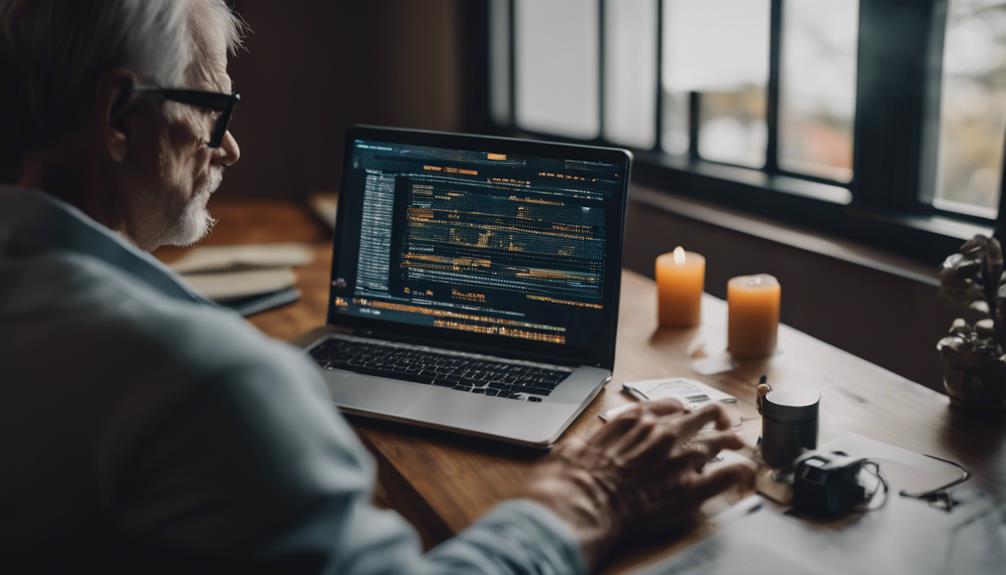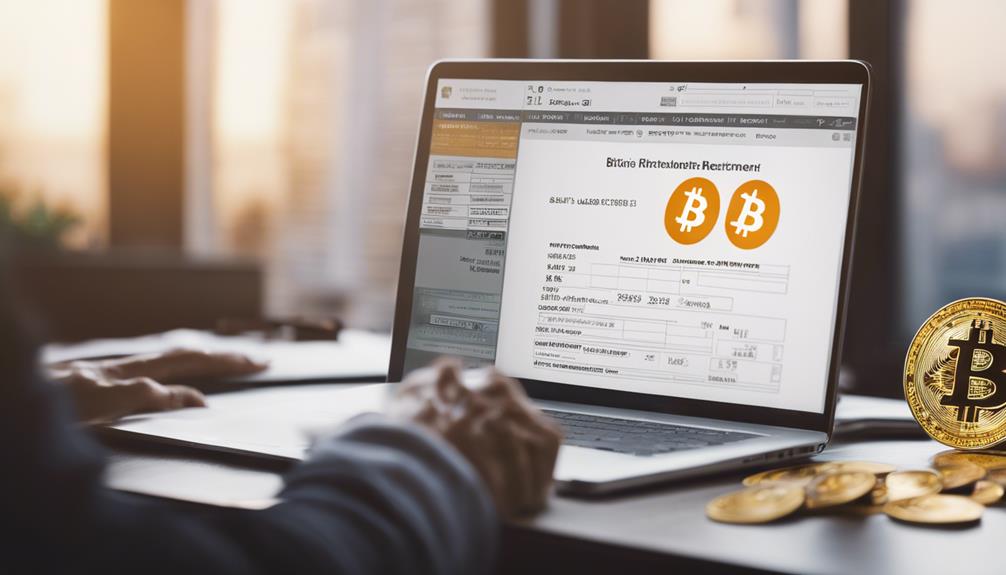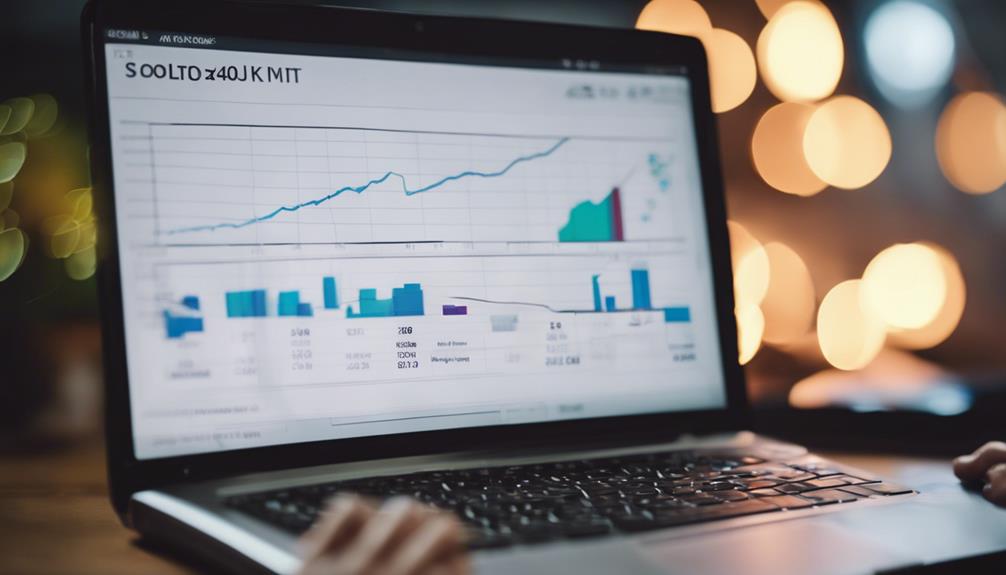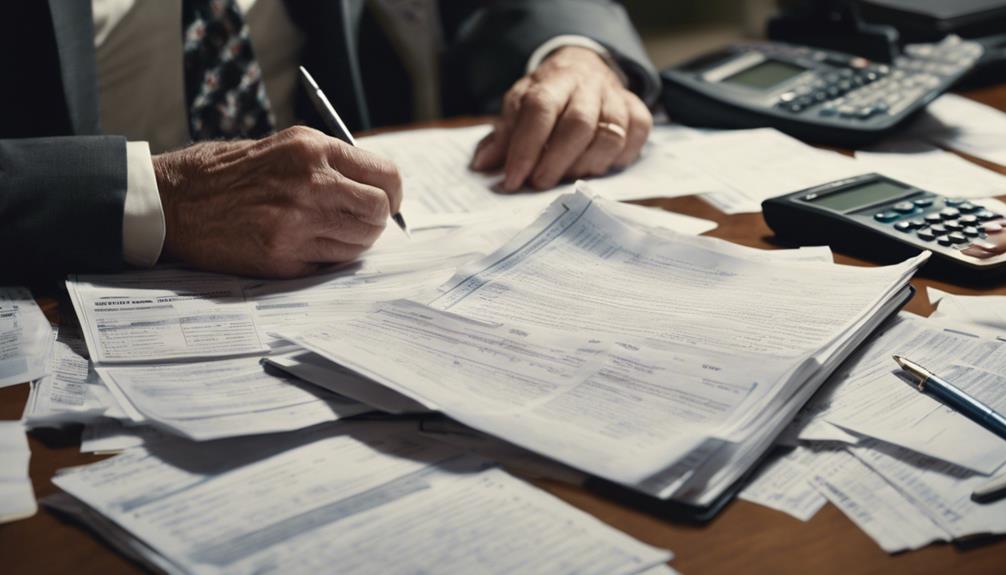We have the option to include Bitcoin in our retirement portfolio through Bitcoin IRAs or Solo 401(k) plans, which offer potential returns and diversification. However, investing in Bitcoin for retirement comes with increased risks due to cryptocurrency volatility. The advantages include higher returns, tax benefits, and protection from market fluctuations, which can lead to long-term growth and diversification beyond traditional assets. When considering investing, self-directed IRAs and Solo 401(k)s are essential, taking into account factors such as contribution limits and selecting a trustworthy custodian. It is important to understand fees, custodian reliability, and aligning with investment objectives. Exploring different custodians and strategies can help in making well-informed decisions for Bitcoin retirement planning.
Key Takeaways
- Consider self-directed IRAs or Solo 401(k) plans for Bitcoin investments.
- Evaluate custodian options for managing Bitcoin in retirement accounts.
- Understand contribution limits and eligibility criteria for adding Bitcoin.
- Research fees associated with Bitcoin IRAs, including setup and custody fees.
- Seek advice from financial advisors to align Bitcoin investments with retirement goals.
Understanding Bitcoin IRAs
When exploring the domain of retirement planning, understanding Bitcoin IRAs proves essential for traversing the world of cryptocurrency investments.
A Bitcoin IRA is a self-directed individual retirement account tailored for digital assets like Bitcoin. Approximately 3% to 5% of all IRAs include alternative investments such as crypto, highlighting the growing interest in diversifying retirement portfolios with digital currencies.
Investing in Bitcoin through an IRA can offer potential returns and diversification, but it also introduces additional risks due to the volatile nature of cryptocurrencies. Key components of a Bitcoin IRA include custodians, secure storage solutions, and access to crypto exchanges for buying and selling.
One of the main attractions of holding Bitcoin in an IRA is the potential for tax advantages, making it a compelling option for those looking to incorporate digital assets into their retirement strategy. Understanding the nuances of a Bitcoin IRA is pivotal for making informed investment decisions and maximizing the benefits of this innovative retirement vehicle.
Benefits of Bitcoin in Retirement

Including Bitcoin in a retirement account can offer significant diversification benefits due to its non-correlation with traditional assets. When considering Bitcoin for retirement savings, it's important to understand the advantages it brings. Here are some key benefits of incorporating Bitcoin into your retirement portfolio:
- Potential for Higher Returns: Bitcoin has shown the potential for significant returns compared to traditional assets.
- Tax Advantages: Holding Bitcoin in a retirement account can provide tax advantages by avoiding capital gains taxes.
- Protection from Market Volatility: Bitcoin can help protect your savings from the unpredictable swings of the market.
- Compounding Growth: With the compounding growth potential of Bitcoin and its tax benefits, your retirement savings could grow substantially.
- Diversification: By adding Bitcoin to your retirement portfolio, you can diversify your investments beyond traditional assets, reducing overall risk.
Considering these benefits, it's important to weigh the pros and cons before making decisions about including Bitcoin in your retirement accounts.
Opening a Self-Directed IRA

Want to take control of your retirement investments and explore alternative assets like digital currencies and real estate? Consider opening a self-directed IRA. Self-directed IRAs offer the flexibility to invest in non-traditional assets, providing opportunities to diversify your portfolio beyond stocks and bonds. With contribution limits mirroring those of traditional IRAs – $6,000 for individuals under 50 and $7,000 for those over 50 – individuals with U.S. taxable income can venture into this investment avenue. In a self-directed IRA, the custodian safeguards the assets while you oversee the asset portfolio, giving you a hands-on approach to your investments. River collaborates with Rocket Dollar, streamlining the setup process for self-directed IRAs tailored to alternative assets. Check out the table below for a brief overview of self-directed IRAs and what they entail:
| Key Aspect | Details |
|---|---|
| Investment Options | Alternative assets like digital currencies and real estate |
| Contribution Limits | $6,000 for under 50, $7,000 for over 50 |
| Custodian Role | Safeguarding assets |
| Setup Assistance | River partners with Rocket Dollar |
Buying Bitcoin in SDIRAs

To purchase Bitcoin in a Self-Directed IRA (SDIRA), individuals can explore alternative asset options beyond traditional investment vehicles. When considering buying Bitcoin in SDIRAs, there are essential factors to keep in mind:
- Choose a Reliable Custodian: A custodian plays an important role in securing assets within your SDIRA.
- Understand Investment Limits: SDIRAs have similar contribution limits to traditional IRAs, ensuring compliance with regulations.
- Eligibility Requirements: Individuals with U.S. taxable income can open and fund a SDIRA for Bitcoin investments.
- Asset Portfolio Management: As the account owner, you're responsible for managing the assets in your SDIRA effectively.
- Consider Rocket Dollar: River partners with Rocket Dollar to simplify the process of setting up SDIRAs for investing in Bitcoin and other alternative assets.
Bitcoin in 401(k) Accounts

Bitcoin's inclusion in 401(k) accounts offers a vital avenue for diversifying retirement portfolios beyond traditional investments. While some 401(k) plans, like ForUsAll and potentially Fidelity, allow holding assets in cryptocurrencies such as Bitcoin, most plans don't currently offer this option due to fiduciary rules.
However, small business owners have the opportunity to explore alternative investments, including Bitcoin, through solo 401(k) plans. These specialized plans not only enable holding cryptocurrencies but also provide higher contribution limits compared to IRAs.
For those seeking to enhance their retirement savings with Bitcoin investments, solo 401(k) plans present a promising avenue. By taking advantage of the flexibility and broader investment options offered by these plans, individuals can strategically incorporate cryptocurrencies into their retirement portfolios.
Before making any investment decisions, it's important to thoroughly research and understand the implications of holding Bitcoin within a retirement account to ensure alignment with long-term financial goals.
Investing With a Solo 401(K)

When considering investing with a Solo 401(k), it's crucial to understand the basics of this retirement account. Setting up the account involves a few key steps to guarantee a smooth process.
Additionally, exploring Bitcoin investment options within a Solo 401(k) can provide diversification and potential growth opportunities for retirement savings.
Solo 401(K) Basics
How can small business owners maximize their retirement savings through a Solo 401(k) plan?
- Solo 401(k) plans allow for higher contribution limits than traditional IRAs.
- These plans offer the flexibility to include cryptocurrencies in your retirement portfolio.
- Investing in Bitcoin within a Solo 401(k) can provide diversification and potential growth opportunities.
- Small business owners can take advantage of tax benefits and explore alternative investment options with Solo 401(k) plans.
- By leveraging the features of Solo 401(k) accounts, individuals can secure their financial future through a well-diversified and potentially lucrative retirement portfolio.
Setting Up Account
Our process for setting up an account with a Solo 401(k) involves completing the necessary paperwork and selecting investment options. To begin, choose a qualified custodian or IRA provider experienced in handling alternative assets like cryptocurrencies. Confirm the custodian supports investing in Bitcoin within an individual retirement account.
Once you've selected a provider, you'll need to fill out the required paperwork to establish your Solo 401(k) account. This paperwork typically includes details about your investment preferences, risk tolerance, and personal information. It's important to provide accurate information to facilitate a smooth setup process.
Bitcoin Investment Options
Exploring diverse investment avenues, such as Bitcoin, within a Solo 401(k) can enrich retirement portfolios with potential growth opportunities in digital assets.
- Bitcoin IRA requires careful consideration before investing in crypto.
- Traditional or Roth IRA accounts may limit exposure to alternative assets like Bitcoin.
- Solo 401(k) plans enable investing in Bitcoin with higher contribution limits.
- Small business owners can diversify their retirement savings through digital assets.
- Investing in Bitcoin through a Solo 401(k) aligns retirement goals with the potential growth of cryptocurrencies.
Evaluating Bitcoin IRA Options

When evaluating Bitcoin IRA options, it is important to contemplate the different custodians available for secure storage solutions of digital assets. Selecting a reputable custodian is essential for safeguarding your Bitcoin investments within a tax-advantaged retirement account. These custodians offer secure storage to protect your assets while allowing for diversification in your portfolio with exposure to cryptocurrency. To assist in your evaluation, consider factors such as fees, potential returns, and the custodian's track record in handling digital assets. Below is a table highlighting key aspects to take into account when choosing a custodian for your Bitcoin IRA:
| Criteria | Description |
|---|---|
| Security | Ensure robust security measures are in place to protect your assets. |
| Reputation | Look for a custodian with a proven track record in handling digital assets. |
| Fees | Consider the setup, transaction, and management fees associated with the custodian. |
Carefully analyzing these factors will help you make an informed decision when selecting a custodian for your Bitcoin IRA.
Considerations for Bitcoin Fees

As we shift focus to 'Considerations for Bitcoin Fees', understanding the cost structure associated with Bitcoin IRA custodians becomes essential in managing your retirement investments effectively. When considering Bitcoin IRAs, here are some significant points to keep in mind:
- Setup Fees: Bitcoin IRA custodians may charge setup fees ranging from $50 to $1000.
- Custody Fees: Recurring custody and management fees for Bitcoin IRAs can be around 1% to 2% annually.
- Trading Fees: Fees for buying and selling Bitcoin within IRAs can range from 1% to 2% per transaction.
- Risk Justification: Higher fees in retirement accounts are justified by added risk and compliance requirements for Bitcoin investments.
- Tax Implications: Consult with tax professionals to understand the tax implications and potential deductions related to Bitcoin IRA fees.
Considering these factors won't only help you navigate the fee structure associated with Bitcoin IRAs but also assist you in making informed decisions about your retirement investment strategy.
Choosing a Bitcoin Retirement Strategy

Considering your retirement goals and risk tolerance, selecting the most suitable Bitcoin retirement strategy is essential for maximizing potential returns and diversifying your portfolio effectively.
When evaluating different options, two main approaches stand out: self-directed IRAs and custodian-managed options. Self-directed IRAs offer more control over your investments, allowing you to choose specific cryptocurrencies like Bitcoin. On the other hand, custodian-managed options provide a more hands-off approach, where a custodian oversees the investments on your behalf.
Before making a decision, it's vital to assess your risk tolerance and align your investment goals with the chosen strategy. Researching custodians and platforms that support Bitcoin investments in retirement accounts is also paramount. Seeking advice from financial advisors or professionals specializing in cryptocurrency retirement investments can provide valuable insights to make informed choices.
Frequently Asked Questions
Can You Transfer Bitcoin to Ira?
Yes, we transfer Bitcoin to an IRA. It involves setting up a self-directed IRA, funding it, and buying Bitcoin within the account. This move offers tax benefits and diversification for our retirement savings.
Should I Put My Retirement in Bitcoin?
We must weigh the risks and potential gains of placing our retirement funds in Bitcoin. Understanding our risk tolerance and investment goals is vital. Diversification is key to managing risks. Consulting a financial advisor is wise.
How Do I Transfer Bitcoin to My Account?
To transfer Bitcoin to our account, we need to set up a self-directed IRA, fund it, and purchase Bitcoin through the account. Utilizing a custodian experienced in cryptocurrency can streamline the process for a smoother transfer.
How Do I Add Money to My Retirement?
We boost retirement savings by contributing consistently from our paycheck or taking advantage of employer matches. Rollovers from existing accounts and catch-up contributions over 50 enrich our funds. Automatic transfers support steady growth.
Is Adding Bitcoin to Your Retirement Account a Good Idea for Beginners?
When it comes to bitcoin IRA retirement planning, beginners should weigh the risks and rewards. Adding Bitcoin to your retirement account can diversify your portfolio, but it’s important to understand the volatile nature of cryptocurrency. Seek professional advice before making any decisions.
Conclusion
To sum up, contemplating Bitcoin for your retirement account can be a wise investment strategy for those seeking to diversify their portfolio and potentially increase their returns.
By recognizing the benefits of Bitcoin in retirement, opening a self-directed IRA, and evaluating different Bitcoin IRA options, you can make informed decisions about incorporating cryptocurrency into your long-term financial planning.
Remember to take into account fees, select a retirement strategy, and consult with a financial advisor for personalized guidance.











